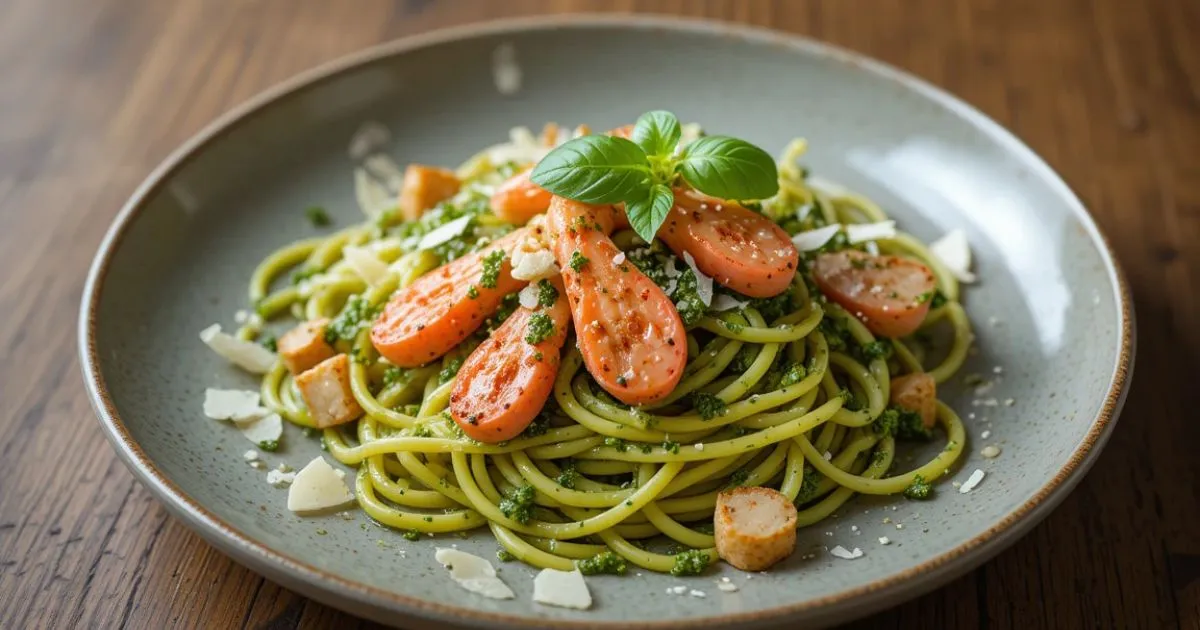Sauté sliced zucchini in olive oil until lightly browned, then cook langostinos with garlic and butter until just pink and set them aside. Toss everything together with a fresh pesto sauce—either homemade or store-bought—and your favorite al dente pasta (or zucchini noodles for a low-carb twist). Finish by adding a sprinkle of Parmesan cheese and fresh basil for an irresistible, restaurant-worthy meal.
Pesto Langostino Zucchini Recipes
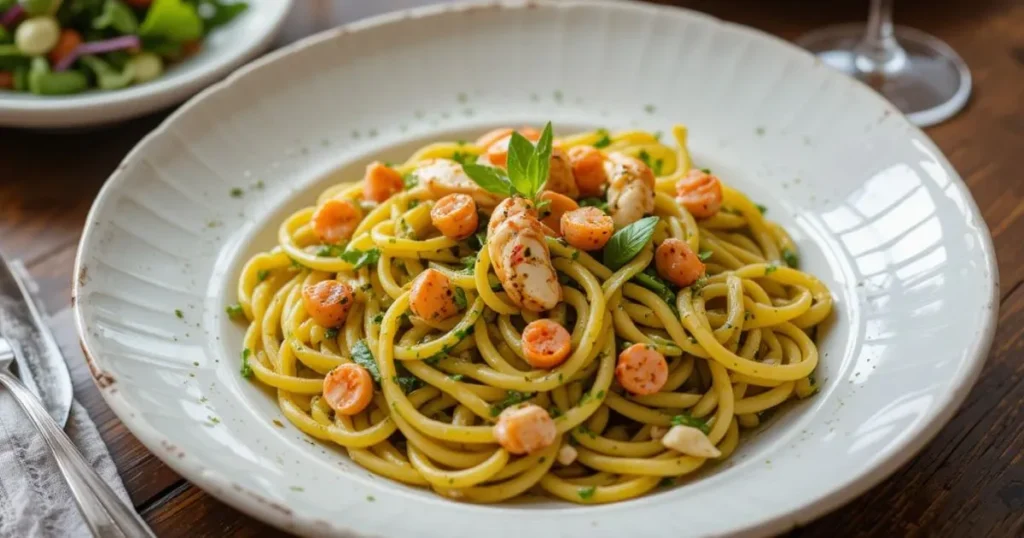
Table of Contents
Introduction: Pesto Langostino Zucchini Recipes
Ready to whisk your taste buds away on a mini vacation? That’s exactly what happens when fresh pesto, tender langostino, and crisp zucchini decide to party on your plate! If you’ve never tried combining these three power ingredients before, buckle up—this is a dish that’s about to steal the show at your next dinner.
From choosing the freshest zucchini to mastering homemade pesto (yes, it’s easier than you think!), we’ve got all the pointers you need right here. Get ready to tantalize your senses and impress anyone lucky enough to snag a seat at your table. Stick around, because the secret tips and techniques we’re about to share will make you the star of your own kitchen—no fancy chef title required!
Understanding the Star Ingredients
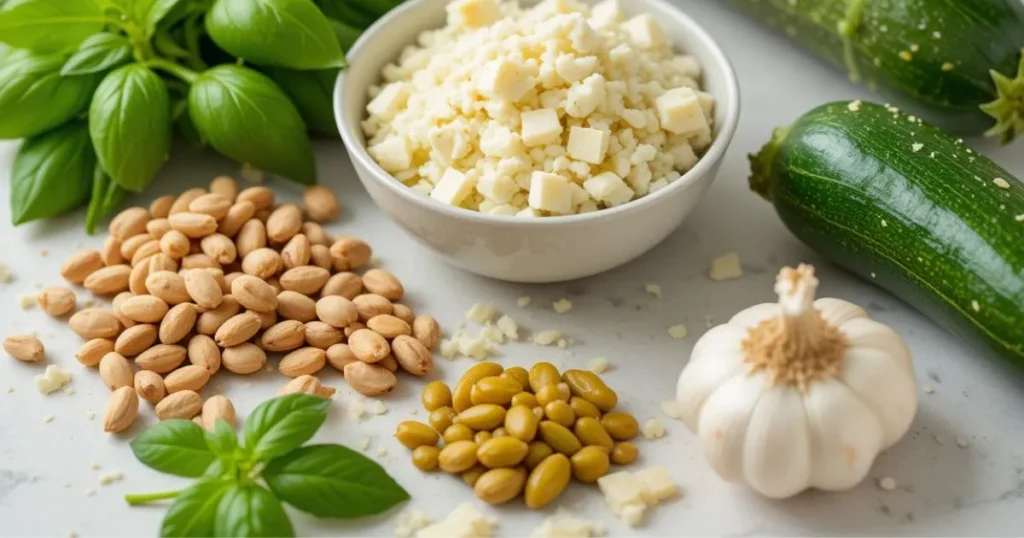
When it comes to creating a show-stopping pesto langostino zucchini dish, it’s all about knowing your key players. Think of this section as your backstage pass to the most dazzling performers in your kitchen—langostino, zucchini, pesto, and the perfect pasta. Let’s dive in!
Langostino 101 :
What exactly are langostinos?
- Tiny treats of the sea: They look like small lobsters but have a sweeter, more delicate flavor.
- Not shrimp, not lobster: They’re somewhere in-between, making them a unique and versatile seafood option.
Differences between langostino and lobster (taste, texture, and availability)
- Texture: Lobster is usually firmer; langostino is tender and less chewy.
- Flavor: Langostino has a sweeter, milder bite—perfect for letting pesto’s herbs shine.
- Availability: Lobsters can cost a pretty penny and may be seasonal, while langostino is often sold cooked and frozen year-round.
How to select fresh or high-quality langostinos (frozen vs. fresh)
- Frozen finds: Most langostinos you’ll see at the store are pre-cooked and frozen—just look for those labeled “wild-caught” or reputable brands.
- Fresh check: If you stumble upon fresh ones, make sure they’re firm, smell briny but not fishy, and have a bright color.
- Storage tip: Keep them chilled until you’re ready to toss them into your pesto party.
Zucchini Essentials :
Picking the freshest zucchini (size, color, firmness)
- Size matters: Smaller zucchini (6-8 inches) tend to be sweeter and less seedy.
- Color and firmness: Look for vibrant green skin without soft spots; the skin should be glossy and firm to the touch.
- Pro tip: If you can bend it, it’s probably past its prime—no limp zucchinis allowed!
Why zucchini is a perfect companion to pesto and seafood
- Soaks up flavor: Mild in taste, zucchini happily absorbs all that garlicky, herby pesto goodness.
- Texture contrast: Slight crunch from zucchini pairs beautifully with tender langostino.
- Health bonus: It’s low in calories but high in vitamins, so you can feel good piling it onto your plate.
Types of Pesto Sauces :
Classic basil pesto vs. other variations (spinach, kale, sun-dried tomato)
- Basil pesto: The OG—bright, fragrant, and delightfully garlicky.
- Spinach or kale pesto: A nutrient-packed twist, still deliciously creamy with the right blend of nuts and cheese.
- Sun-dried tomato pesto: Tangy and slightly sweet, adding a richer color to your dish.
The role of healthy fats in pesto and how it enhances flavor
- Olive oil: Acts like a smooth operator, helping blend the herbs and nuts into a silky sauce.
- Nuts: Whether it’s pine nuts, walnuts, or almonds, they bring richness and creaminess.
- Cheese: Traditional Parmesan or Pecorino packs a savory punch and rounds out the pesto’s flavor profile.
Choosing the Right Pasta :
Ideal pasta shapes for pesto-based dishes (linguine, penne, fusilli, etc.)
- Long noodles: Linguine or spaghetti let the pesto hug every strand.
- Short, ridged shapes: Penne, fusilli, or rotini grab onto the sauce in every nook and cranny.
- Curly cues: Fusilli or cavatappi add a playful twist (literally) that kids and grown-ups love.
Gluten-free, whole wheat, and low-carb options
- Gluten-free: Brown rice pasta or quinoa-based noodles can be just as tasty—just watch the cooking time to avoid mushiness.
- Whole wheat: Adds a nutty flavor and extra fiber.
- Low-carb: Swap pasta entirely for zucchini noodles (aka “zoodles”) and never miss the wheat.
Keep these star ingredients top of mind, and you’re on your way to crafting a pesto langostino zucchini dish worthy of a standing ovation. Next up, we’ll dive into exactly how to put them all together for a recipe that’ll make taste buds sing
Essential Kitchen Tools and Preparation Tips
When you’re aiming for a top-tier pesto langostino zucchini dish, you’ll need the right tools and savvy prep skills. Think of this as setting the stage before the big performance—get everything in order, and you’ll be on your way to a standing ovation in the kitchen!
Must-Have Equipment
- Food Processor or Blender
Whether you’re crushing basil leaves or swirling spinach into a verdant pesto, these gadgets are your backstage VIPs. A regular blender works fine, but if you want a truly silky sauce, a food processor can create that perfect creamy texture. - Spiralizer or Vegetable Peeler (Optional)
Dreaming of those Instagram-worthy zucchini noodles (zoodles)? A spiralizer turns your zucchini into perfect swirls, while a regular vegetable peeler can produce thin ribbons. Both methods are fun, and they make a tasty low-carb alternative to pasta! - Proper Pots and Pans
A trusty saucepan for boiling pasta (or even blanching your zucchini) and a nonstick skillet for sautéing langostinos are essential. Make sure your pans are big enough—you don’t want your ingredients cramped and fighting for space!
Ingredient Selection and Storage
- How to Store Fresh Basil, Langostino, and Zucchini
- Basil: Keep the stems in a glass of water on your countertop like you would fresh flowers. Avoid the fridge unless you want droopy leaves.
- Langostino: If frozen, stash it in the coldest part of your freezer. Once thawed, pat dry and use within a day or two for the best taste.
- Zucchini: Store unwashed in the crisper drawer, ideally in a produce bag. If it starts turning soft or showing wrinkly skin, time to cook it ASAP!
- Budget-Friendly Shopping Tips and Seasonal Ingredient Variations
- Timing is everything: Basil and zucchini are often cheaper (and tastier) in warmer months, so keep an eye out for sales at your local farmers market.
- Bulk buy and freeze: If you snag a deal on fresh basil or langostinos, freeze the extras so you’re always pesto-prepped.
- Swap it up: Missing basil out of season? Try spinach or kale for a twist on classic pesto. Found a great deal on shrimp? They make an excellent stand-in for langostino.
Step-by-Step Cooking Process
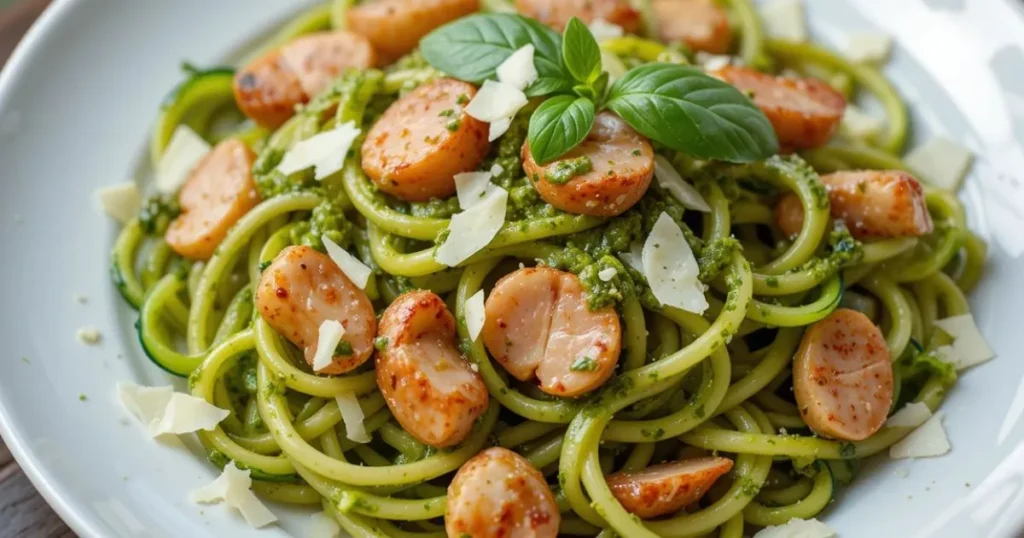
Now that you’re armed with the right tools and star ingredients, it’s time for the main event! Let’s walk through each step of creating your pesto langostino zucchini masterpiece, from blending the perfect sauce to swirling everything together in a glorious finale.
Crafting the Perfect Pesto
- Gather fresh herbs, nuts, cheese, and olive oil
Start with vibrant basil leaves (or spinach, kale—whatever makes your taste buds tingle), plus your choice of nuts (pine nuts or walnuts are classics). Toss in grated Parmesan or Pecorino cheese, garlic, and a drizzle of extra-virgin olive oil. - Achieve the right consistency and flavor balance
Pulse in a food processor until the texture is creamy with a bit of texture—like a sassy pesto dance party. Taste, then tweak by adding more cheese for savoriness or a pinch of salt for extra oomph.
Prepping and Cooking Zucchini
- Slicing, dicing, or spiralizing techniques
Give your zucchini a makeover by slicing it into coins, dicing into cubes, or going full-on spiralizer for beautiful zoodles. The shape you choose impacts the final texture—zoodles make for a lighter feel, while chunks add a more substantial bite. - Sautéing vs. roasting: when and why to choose each method
- Sauté: Perfect if you want a quick sear and to preserve some crunch. Just a little olive oil in a hot pan does the trick.
- Roast: Ideal for a deeper flavor and caramelized edges; spread zucchini on a sheet pan, drizzle with oil, and let the oven work its magic.
Handling and Cooking Langostinos
- Cleaning, deveining, and cooking times
Most store-bought langostinos are pre-cooked and peeled—lucky you! If yours need cleaning, remove any shells and rinse quickly. Keep cooking times short to avoid tough, rubbery seafood. - Sautéing or grilling for maximum flavor
- Sauté: Butter, garlic, and a pinch of salt make them irresistible. Cook just until they turn opaque.
- Grill: For a hint of smokiness, thread them onto skewers and toss ’em on a hot grill for a minute or two per side.
Selecting and Boiling the Pasta
- Cooking time guidelines for al dente texture
Different pastas have different personalities. Read the package directions, then test a noodle a minute or two before the recommended time—you want that classic, slightly firm bite. - Salt and oil in the water: do’s and don’ts
- Do: Generously salt the water to season the pasta from the inside out.
- Don’t: Add oil to the water; it might keep the sauce from clinging to your noodles.
Combining It All
- Layering pesto, zucchini, and langostino with the pasta
Drain your pasta (save a splash of that starchy water!), then stir in pesto until the noodles are luxuriously coated. Gently mix in sautéed zucchini and langostinos, being careful not to break them up. - Balancing flavors, seasoning, and final garnishes
- Taste and tweak: Need more salt, pepper, or even a squeeze of lemon? Go for it.
- Top it off: Sprinkle grated cheese, chopped basil, or a dash of chili flakes for that Instagram-worthy finish.
Once everything’s swirled together in blissful harmony, your pesto langostino zucchini feast is ready to steal the show.
Avoiding Common Pitfalls
Even the most seasoned chefs have their off days, and your pesto langostino zucchini dish is no exception. But fear not! We’re here to help you dodge those kitchen hiccups and ensure your masterpiece turns out flawless every time. Let’s tackle some common challenges head-on with a sprinkle of humor and a dash of wisdom.
Overcooking Seafood
Nobody likes rubbery langostinos sneaking onto their plate. Keep these tips in mind to maintain that tender, succulent texture:
- Signs to watch for to keep langostinos tender
- Opaque Magic: Perfectly cooked langostinos turn a lovely opaque pink. If they’re still translucent, they need a bit more time; if they’re turning white and firm, it’s time to pull them off the heat.
- Feel the Bounce: Gently press a langostino—if it springs back, you’re golden. If it feels mushy, you might’ve gone a bit too far.
- Timing tips for different cooking methods
- Sautéing: A quick 2-3 minutes on medium-high heat is all they need. Stir them continuously in the pan to ensure even cooking.
- Grilling: Just a minute or two per side over high heat will give them that irresistible smoky flavor without drying them out.
- Boiling: If you’re boiling langostinos, don’t let them swim in the pot for more than 3-4 minutes. They cook fast, so set a timer!
Mushy or Undercooked Pasta
Pasta can be a bit temperamental, but mastering it is easier than you think:
- Correct water-to-pasta ratio
- Big Pot, Big Fun: Use at least 4-6 quarts of water per pound of pasta. This gives the noodles plenty of space to dance and prevents them from sticking together.
- Salt It Up: Add a generous handful of salt to the boiling water. It seasons the pasta from the inside out, enhancing every bite.
- Why al dente is key for sauces like pesto
- Texture Triumph: Al dente pasta has that perfect bite—firm but not crunchy. It holds up beautifully when tossed with creamy pesto, ensuring your dish isn’t a soggy mess.
- Sauce Synergy: Pesto clings to al dente noodles like a match made in culinary heaven, providing a harmonious blend of flavors and textures.
Relying on Store-Bought Pesto
Store-bought pesto is convenient, but it can sometimes fall short of homemade glory. Here’s how to elevate it:
- Quality differences between homemade and store-bought
- Freshness Factor: Homemade pesto bursts with fresh herbs and vibrant flavors, while store-bought versions can sometimes taste flat or overly processed.
- Customization: When you make your own, you control the ingredients—whether you like it extra garlicky, cheesy, or nutty.
- How to improve jarred pesto if you must use it
- Fresh Herbs Boost: Stir in a handful of freshly chopped basil or parsley to brighten up the flavor.
- Extra Zing: Add a squeeze of lemon juice or a dash of extra-virgin olive oil to enhance the freshness.
- Nutty Goodness: Toss in some toasted pine nuts or walnuts for added texture and depth.
Preventing Pesto from Browning
Nobody wants a dish that looks as sad as it tastes. Keep your pesto vibrant and appetizing with these tricks:
- Storing pesto properly (adding a thin layer of oil, acid’s role)
- Oil Barrier: Pour a thin layer of olive oil over the surface of your pesto before sealing the container. This creates a protective barrier against air, keeping it bright green.
- Acid to the Rescue: A splash of lemon juice not only adds a zesty kick but also helps preserve the vibrant color by slowing down oxidation.
- Using fresh herbs and quick preparation methods
- Fresh is Best: Opt for the freshest herbs available. Fresher basil means brighter pesto!
- Speedy Prep: The quicker you blend and store your pesto, the less time it has to brown. Don’t let it sit around—use it promptly or freeze it for later.
Serving and Presentation Tips
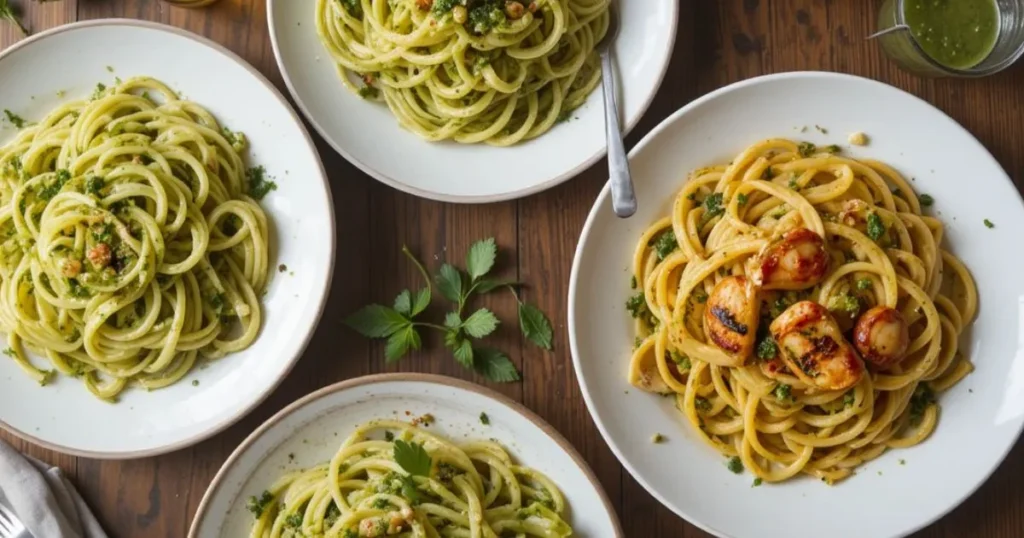
You’ve cooked up a storm with your pesto langostino zucchini masterpiece—now it’s time to make it look as fabulous as it tastes! Presentation is key to turning a delicious dish into a dining experience. Let’s dive into some fun and creative ways to plate, pair, and pour your way to a stunning and scrumptious meal.
Creative Plating Ideas
Turn your plate into a canvas and let your creativity shine! Here’s how to showcase those vibrant pesto swirls and colorful zucchini like a pro:
- Showcase Vibrant Pesto and Colorful Zucchini
- Swirl It Up: Use a spoon or a squeeze bottle to create beautiful pesto ribbons around the plate before adding your pasta.
- Layer with Love: Arrange zucchini ribbons or zoodles in an elegant fan shape beside the pasta for a visually appealing contrast.
- Play with Heights: Stack pasta slightly off the plate’s edge or use a ring mold for a sophisticated tower effect.
- Garnishes Galore
- Fresh Basil Leaves: Sprinkle a few whole or torn basil leaves on top for a burst of green and fresh aroma.
- Shaved Cheese: Add delicate shavings of Parmesan or Pecorino for a touch of elegance and extra flavor.
- Chili Flakes: A sprinkle of red pepper flakes not only adds a pop of color but also a hint of heat for those who like a little kick.
Ideal Side Dishes
No pasta party is complete without some delightful accompaniments. Pair your pesto langostino zucchini dish with these perfect sides to round out your meal:
- Light Salads
- Mixed Greens: Toss together arugula, spinach, and baby kale with a light vinaigrette to keep things fresh and crisp.
- Citrus Salad: Combine orange segments, fennel slices, and a drizzle of honey for a sweet and tangy sidekick.
- Garlic Bread
- Crunchy and Buttery: Serve warm, buttery garlic bread with a crispy crust to mop up any extra pesto goodness.
- Herbed Twist: Add a sprinkle of fresh herbs like parsley or oregano to elevate the flavor profile.
- Roasted Vegetables
- Seasonal Selection: Roast a medley of seasonal vegetables such as bell peppers, cherry tomatoes, and asparagus for a colorful and nutritious addition.
- Honey-Glazed Carrots: Sweet and tender carrots glazed with a touch of honey and thyme make a delightful side.
- Pairing Soups
- Light Broths: A simple vegetable or chicken broth can complement without overpowering your main dish.
- Tomato Bisque: A creamy tomato bisque adds a rich, comforting element to your meal.
Frequently Asked Questions (FAQs)
Can I swap out shrimp for langostino?
Absolutely! Shrimp can be an excellent substitute for langostino in pesto zucchini recipes. Both seafood options offer a similar texture and sweet flavor that complements the pesto sauce. Simply adjust the cooking time as needed, since shrimp may cook slightly faster or slower depending on their size.
How do I make a dairy-free version of the pesto?
Creating a dairy-free pesto is straightforward. Omit the Parmesan or Pecorino cheese typically used and replace it with nutritional yeast or a plant-based cheese alternative to maintain a savory flavor. Additionally, ensure you use high-quality olive oil to enhance the overall taste of your pesto.
What’s the best way to store leftovers?
Store leftovers in an airtight container in the refrigerator for up to three days. To preserve the pesto’s vibrant color and prevent sogginess, keep the pesto separate from the pasta and seafood until you’re ready to reheat and serve. When reheating, gently warm the components on the stovetop or in the microwave, adding a splash of water or olive oil to refresh the sauce.
Can frozen zucchini be used in this dish?
Yes, frozen zucchini can be used, but it’s best to thaw and drain it thoroughly before cooking to avoid excess moisture in your dish. Frozen zucchini tends to be softer, making it ideal for recipes where a tender texture is desired. For a firmer, crisper texture, fresh zucchini is recommended.
How do I keep pesto bright green?
To maintain the bright green color of pesto, add a small amount of lemon juice during preparation to slow down oxidation. Alternatively, blanching the basil leaves briefly before blending can help preserve their vibrant hue. Additionally, storing pesto in an airtight container with a thin layer of olive oil on top can prevent it from turning brown.
Conclusion
Congratulations, culinary adventurer! You’ve journeyed through the vibrant world of pesto langostino zucchini recipes, uncovering everything from star ingredients and essential tools to creative variations and flawless execution tips. Whether you’re whipping up a classic linguine or experimenting with a spicy Calabrian twist, you now have the knowledge and inspiration to create a dish that’s as delightful to make as it is to eat.
Remember, the kitchen is your playground—don’t be afraid to mix things up, try new substitutions, and add your personal flair. With fresh ingredients, the right techniques, and a sprinkle of creativity, your pesto langostino zucchini masterpiece is sure to impress family, friends, and even your own taste buds.
So, grab your favorite pasta, fire up those pans, and let the flavors dance on your plate. Here’s to delicious meals, happy gatherings, and the joy of cooking something truly spectacular. Happy cooking, and may every bite bring a smile to your face!

